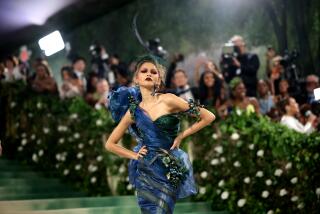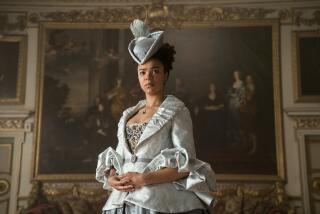Age of Elegance
- Share via
No wonder ladies in the old days needed a whiff of smelling salts from time to time. They dressed in layers--as many as seven, sometimes sweltering under some 25 pounds of clothing and accessories.
For a glimpse of those days of bustles and bloomers, you can drop by the Stagecoach Inn Museum in Newbury Park and see the new exhibit on vintage clothing.
Along with the Victorian wedding gowns, black-beaded mourning jackets and wool bathing suits, you can peruse turn-of-the-century photographs of local pioneering families such as the Haighs, one of the original inn’s many owners, and the Borchards.
The exhibit, on display through September, is from the museum’s permanent collection, donated mostly by area residents and cared for by the museum’s collection manager, Blanca Relle. A few items are on loan, perhaps the most extraordinary being a stuffed bird that once adorned a lady’s hat, which was all the fashion rage at one time. But this is no sparrow--it’s a rare bird of paradise, probably from New Guinea.
Thousand Oaks collector and former dentist Kent Christenson, who picked it up at a secondhand store in Northern California, dates it to the early 1900s because of a ban on exporting the birds from New Guinea after about 1920.
With its long beige tail feathers, yellow head and splash of green on its neck, the bird must have been quite a hit perched elegantly on the head of a socialite. In those days, hat etiquette was important.
“If you went to someone’s house, you left your hat on; but in your own home you could take it off,” said Sandra Hildebrandt, museum director.
For hat fanciers, the exhibit has a bunch, including another one topped by a real bird. But real hat devotees might want to catch a program, “The History of Hats,” Sunday at the museum. The 1:30 p.m. presentation features Rosa Keehn of Monterey Park, who uses funny skits to talk about hat history. She also lets the audience try on some from her collection.
The women’s wear featured in the exhibit dates from about 1875 to 1920, so it runs the gamut--floor-length gowns with petticoats or “bird cage” hoops to gauzy little flapper numbers. There are several wedding gowns, including one silk lace number also shown being worn by a 17-year-old bride in a late 1800s photograph.
A navy middy dress, worn by actress Margaret O’Brien in a stage production of “Gigi,” is on display. Another noteworthy donation is a black velvet and fur cape decorated with ostrich feathers that was owned by the Dominguez family, original holders of a Spanish land grant in the area.
Some of the more intriguing items aren’t clothing at all. A man’s watch fob is fashioned from woven strands of brown hair, presumably from a loved one. A tiny piece of cherished braided hair is encased in a jeweled pin.
“We find it macabre--they found it sentimental,” Hildebrandt said.
The exhibit even has a small dish with a lid called a “receiver,” in which women would store the hair gleaned from their brushes. “You could send hair to Sears, Roebuck and they would weave it for you,” she said.
You’ll see beaded handbags, jeweled hat pins, parasols and fans, even one fashioned from ostrich feathers.
“Every woman had a fan,” Hildebrandt said. “There was a whole language of the fan--’I’d like to go home,’ ‘I like you,’ ‘You’re really boring.’ ”
Interspersed among the clothing, shoes, gloves and hosiery are a few old magazines from the era, which show fashion styles. Perhaps more interesting is that a copy of Ladies Home Journal in 1895 was a dime, and a 1905 issue of the Saturday Evening Post was only a nickel.
BE THERE
The Stagecoach Inn Museum is at 51 S. Ventu Park Road, Newbury Park. Hours are Wed.-Sun., 1-4 p.m. Admission is $3 for adults, $2 for seniors, and $1 for children over 5. For information, 498-9441.
More to Read
Sign up for The Wild
We’ll help you find the best places to hike, bike and run, as well as the perfect silent spots for meditation and yoga.
You may occasionally receive promotional content from the Los Angeles Times.






